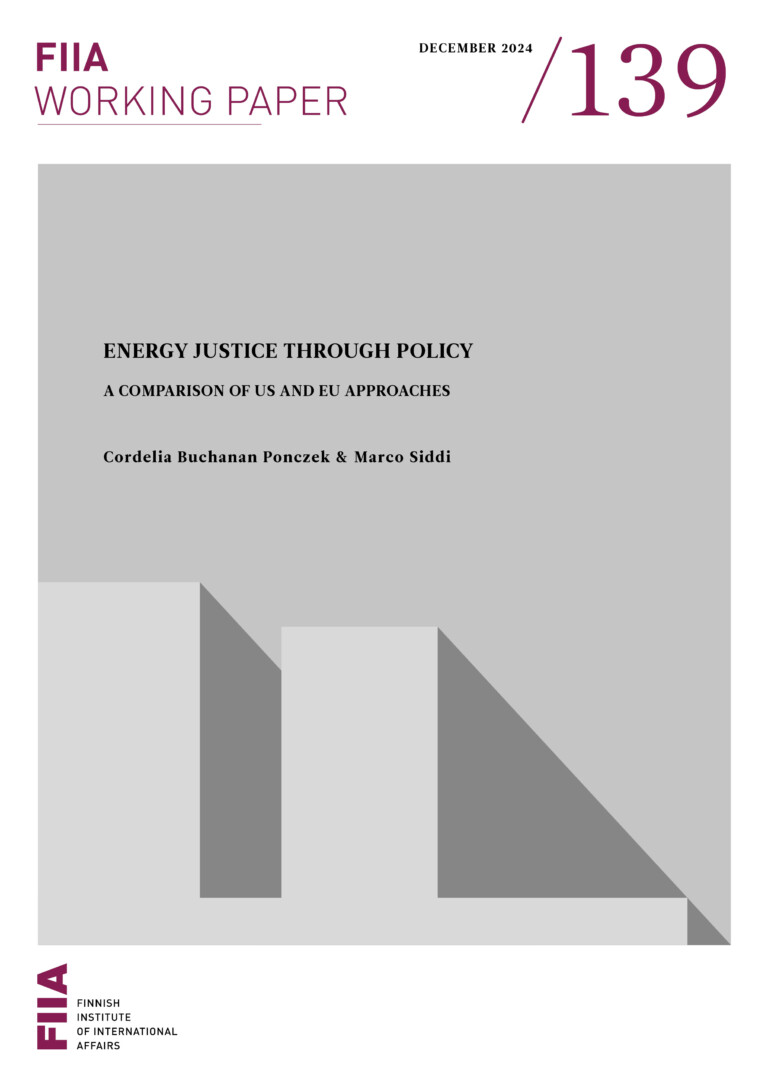The new EU leadership has restructured the way the European Commission manages its external relations. The High Representative/Vice-President, Federica Mogherini, was formally put in charge of coordinating the work of the Commissioners’ Group on External Action and relocated her offices to the Commission building.
Under the new approach, the Commission aims to be more closely involved in the preparation of Foreign Affairs Council meetings. Regular meetings of external action Commissioners are supposed to foster a common position, as well as increase the Commission input on sectoral policies and instruments ahead of ministerial meetings.
In the face of the gravitational shift towards the Commission, it is in the interests of member states to ensure that the EEAS remains, despite all its teething troubles, the political hub of EU external relations, and to invest in its development accordingly.
An in-depth examination of the externally relevant policies within the remit of the Commission reveals that, across all issues, EU foreign policy can improve by a joint approach combining the political perspective of the EEAS with the sectoral expertise of the Commission.
In November 2014, the new President of the Commission, Jean-Claude Juncker, and his new team of Commissioners, moved into their offices in the Berlaymont building in Brussels. Juncker duly promised to reform the working methods of the Commission. While the previous Commission, under its President José Manuel Barroso, lacked sufficient coordination of policies by the 27 Commissioners, the new set-up introduced so-called ‘project teams’, each headed by one of the seven Vice-Presidents of the Commission.
The move towards a more hierarchical system chimes well with the idea of a more coherent EU foreign policy, as envisaged in the Lisbon Treaty. Since 2009, the High Representative of the EU has also been the Vice-President of the European Commission (the abbreviation thus being HR/VP). Yet, during the term of the previous High Representative, Catherine Ashton, the VP role was de facto never activated. Now, the new Commission set-up promises to introduce better coordination among Commissioners with external action portfolios, and with the new HR/VP, Federica Mogherini, taking the formal lead and having the final say on external Commission initiatives.
Nonetheless, some questions remain. What are the details concerning the changes in the new Commission system, and how do they affect the relationship with the European External Action Service (EEAS)? This paper starts with a brief history of the fluctuating external relations structures of the Commission, before discussing in depth the changes under current Commission President Juncker. In particular, the analysis clarifies that, while some of the changes can be labelled as ‘fine-tuning’, the new Commission machinery on external action is bound to be more political and more closely involved in the steering of the foreign policy agenda. This shift of the policy-planning centre of gravity towards the Commission might have an impact on the finely calibrated balance of the overall EU foreign policy architecture that member states monitor so carefully.
In order for the system to work, it is important that a more pronounced role for the Commission in foreign policy planning does not result in a decline in the status of the EEAS as the EU foreign policy hub. While the close involvement of the Commission policies at an early stage is to be welcomed, the Brussels executive branch is still dependent on the member states, which remain the main drivers and decision-makers of EU foreign policy. Between these two players, the member states’ governments and the supranational executive branch, the EEAS remains an important administrative link.
Background: the pressure for Commission reform
It is a commonplace observation that the EU is struggling to use its financial and economic competences under the administrative remit of the Commission in concert with its political instruments of the intergovernmentally organized Common Foreign and Security Policy (CFSP). This lack of so-called ‘horizontal coherence’ of the EU’s activities was one of main drivers behind the Lisbon Treaty reform and continued to be a source of frustration in the last institutional cycle of the EU.
The Commission and the new EEAS were not able to coordinate their policies effectively, even though the sectoral competences of the Commission, ranging from negotiating free-trade agreements to administrating development aid, have far-reaching consequences for the EU’s presence on the global stage. While some of the challenges can be attributed to the tedious set-up process of the new EEAS, another key obstacle to a smooth-running EU foreign policy machinery has been the faulty internal organization of the European Commission.
The structures that organize the external action of the Commission have historically been extremely fluctuant and subject to constant rearrangements. A Directorate-General for external political relations was established for the first time in 1993 as a reaction to the newly created CFSP. In 1995, incoming Commission President Jacques Santer aimed at further increasing the weight of the Commission by allocating external portfolios to six Commissioners along geographical rather than functional lines. While one Commissioner was responsible, for example, for all policies towards Central and Eastern European countries, another Commissioner dealt with the Southern Neighbourhood. The presence of six Commissioners certainly made an impression in Council meetings, yet the holistic approach to regions did not bring the anticipated added value and only exacerbated the incoherence of EU external relations.
In 1999, the Prodi Commission reintroduced thematic Commissioners and installed Chris Patten as the ‘External Relations Commissioner’ with an elevated coordination role over a group of Commissioners with externally relevant portfolios (the Relex group). This revamp coincided with the creation of the post of the High Representative for the CFSP in the Council, taken over by Javier Solana. For a period of time, the fruitful personal cooperation of Patten and Solana succeeded in masking the structural deficit of the EU’s foreign policy.
However, problems resurfaced when Barroso took over the Commission Presidency in 2004 and deprived groups of Commissioners of their power. The incoming External Relations Commissioner, Benita Ferrero-Waldner, had less power in the Commission, as Barroso himself laid claim to the external steering role. The result was a silo structure in the Commission whereby every service followed its own goals, hampering a coherent approach.
The entry into force of the Lisbon Treaty in 2009, despite its good intentions, led to an almost total breakdown of the Commission’s internal coordination system. As the Directorate General for External Relations moved to the newly created EEAS, the Commission lost its internal capacity to orchestrate its external relations portfolios. Some reinforcements in the General-Secretariat of the Commission and in the Directorate-General for Development Cooperation were not enough to fully compensate for this loss.
Furthermore, despite her double-hatted role, Catherine Ashton was not in a position to carry out her role as Commission Vice-President in charge of external relations. Ashton’s office was not embedded in the Commission structures and much of the attention in the system was focused on building up the EEAS. Even though there was formally a group of external relations Commissioners, its role was limited and without any formal standing in the Commission hierarchy.
The new Juncker Commission thus represented the possibility of a fresh start. External pressures stemming from the Ukraine crisis, as well as the unstable Southern neighbourhood and Middle East, underlined the need for reform and for better coordination of different policy initiatives within the remit of the Commission.
A more political and involved Commission
Juncker used the window of opportunity to introduce quite a significant reshuffle in the way the Commission is organized when he assumed office last November. The introduction of Vice-Presidents in charge of project teams of Commissioners marks a significant shift in how the Commission is managed. Mogherini was put in charge of the Commissioners’ Group on External Action (formerly External Relations).
She received the authority from Juncker to ‘guide the work’ of a core group, which includes the Commissioners for European Neighbourhood Policy and Enlargement Negotiations; Trade; International Cooperation and Development; and Humanitarian Aid and Crisis Management.
The group also includes a second layer of Commissioners with a strong external dimension, namely Commissioners for Climate Action and Energy; Transport; as well as Migration and Home Affairs. In these areas Mogherini did not receive the mandate to give guidance, but can ‘draw on the Commission’s policy instruments and expertise’.1
Beyond coordination within her own group, Mogherini also coordinates with relevant Vice-Presidential colleagues. Noteworthy here are Vice-President Maroš Šefčovič for the Energy Union, due to the external relevance of this policy initiative, as well as Vice President Valdis Dombrovskis for the Euro and Social dialogue in matters of external representation of the Euro area. As the operational budget of the CFSP continues to be managed by the Commission, coordination with the Vice-President for Budget and Human Resources, Kristalina Georgieva, will be relevant as well.
Mogherini has pledged to put more emphasis on her role as Commission Vice-President and thus to approach her double-hatted role in a different way compared to her predecessor: “The High Representative is also Vice-President of the Commission, and I intend to play this role to the full”.2 While it is only a symbolic move at first sight, relocating her office to the Commission’s Berlaymont building may prove significant. Her advisory team of ten – half of them coming from member states and the other half having a background in the Commission – is more closely embedded into the Commission structures than before. Regular meetings are held where Cabinet Heads of External Relations Commissioners coordinate the policy lines and travel schedules of their superiors. In addition, each cabinet member is explicitly assigned to liaise with a Commission Directorate-General in a particular policy area.
Mogherini outlined a new approach for her chairmanship of the Foreign Affairs Council at the meeting on 17 November 2014. The ministerial meetings will be planned further in advance and will more closely involve the Commission expertise on horizontal issues. In this way, Mogherini wants to smooth out the foreign policy-making process and ensure that all the relevant parts of the machinery are integrated in a joined-up approach. After all, the weakest spot concerned the last administration’s ability to set the agenda and to ensure the input and engagement of the Commission and all member states.
In practice, the Commissioners’ Group on External Action already started with a new routine of preparing thematic dossiers ahead of foreign minister meetings, with the focus on horizontal aspects such as energy relations or the common commercial policy. By way of example, the preparatory meeting at the beginning of December 2014 had EU-Russia relations as its main theme. It was also attended by Vice-President Maroš Šefčovič, who is responsible for the Energy Union. The Commissioner meetings are in turn prepared at the Cabinet level. In addition, the Commission College meetings, in which all Commissioners take part, have the novelty of extensive foreign policy debriefings led by Mogherini.
On paper, these ‘fine tunings’ merely seem to be a logical upgrade of coordination efforts. In reality, they have a notable impact on the inter-institutional balance of EU foreign policy-making. Since the start of the CFSP in the Maastricht Treaty of 1993, member states had been limiting the political stewardship to the Council Secretariat and the rotating Presidency, and later to the EEAS. During the 2002/2003 European Convention that led to the provisions of the Lisbon Treaty, a possible transfer of the High Representative’s functions to the Commission was subject to intense debate among member-state representatives. A supranational model, where the Commission would set the agenda and represent member states on CFSP matters, was a red line for delegates, especially from Sweden, the UK and Ireland.
The intergovernmental treaty provisions are now supranationalized in practice to a limited extent. While the Lisbon Treaty competences stayed the same, the Commission generally became more closely involved in the agenda management of the Foreign Affairs Council. At the same time, the boundaries between CFSP policies and Commission policies are becoming more blurry and the relevance of the Commission-led sectoral policy fields is becoming more obvious. Accordingly, the Commission is also the beneficiary of a trend that is well-known from the national level: in a post-Westphalian interconnected world, foreign policy has ceased to be the exclusive domain of foreign ministries, which are gradually being substituted by sectoral ministries and their expertise and international networks.
As the Commission is more closely involved in the external agenda management, it will have to take more and more political positions when developing its initiatives for the foreign ministers. Smooth coordination with the relevant EEAS units and Council bodies will be more necessary than ever in order to avoid nasty surprises. After all, the member states in the Council remain the key decision-makers and decide unanimously on most foreign policy matters.
The key external Commission portfolios
A closer examination of several policy fields within the remit of the Commission reveals that EU foreign policy can improve by a joint approach combining the political perspective of the EEAS with the sectoral expertise of the Commission. Some parts of the machinery have been adjusted slightly. The organization of the European Neighbourhood Policy has come in for criticism in recent years, with Germany in particular promoting the idea of handing the sole responsibility for neighbourhood matters over to the EEAS. A complete transfer to the service is off the agenda, as a separate Commissioner was seen as being increasingly useful to assure coordination with other Commission instruments and policies, and to ease the workload of the HR/VP.
[caption id="attachment_83676" align="alignleft" width="1000"] HR/VP Federica Mogherini visited Washington, D.C. in January 2015, pictured here
HR/VP Federica Mogherini visited Washington, D.C. in January 2015, pictured here
with the U.S. Secretary of State John Kerry. Photo: Yuri Gripas / EEAS Flickr.[/caption]
Modest administrative changes await the new Neighbourhood and Enlargement Negotiations Commissioner, Johannes Hahn. A new Directorate-General for Neighbourhood and Enlargement Negotiations (DG NEAR) is being set up in the Commission, bringing together the former Directorate-General for Enlargement and the units of the Directorate-General for Development Cooperation dealing with the neighbourhood, including the financial assistance programmes in the region. Hahn will consequently have direct access to the administration of the EU’s financial instruments in the neighbourhood. However, this is not a bold change, as the respective units were already reporting directly to his predecessor.
The working relationship between the HR/VP and the Neighbourhood Policy Commissioner has been more formalized and features a clear mandate to deputize for Mogherini on trips and to work under her guidance. Their offices even share the same corridor. However, the jury is still out: the litmus test for the new fine-tuned EU neighbourhood policy machinery will be the vaguely defined review of the European Neighbourhood Policy in 2015, which will also require close cooperation with Commissioners responsible for migration and home affairs as well as trade and energy.
The development cooperation machinery has seen some changes in recent years, especially with regard to the programming of the financial assistance instruments. The responsibility for the political preparation of the programming cycle has shifted to the EEAS. This new involvement of the EEAS in the aid planning was either seen as too much (by the development constituency, fearful of a politicization of aid instruments), or as too little (by some member states which hoped to use the aid programmes as a political lever).
In the end, the programming of the 2014–2020 funding instruments was concluded quite smoothly in 2014, not least because the EEAS involvement was still limited, due to its recent establishment and insufficient resources. There is reason to believe that the EEAS will step up its engagement in development questions: in the new institutional cycle, the focus will be on development diplomacy. The main issues on the table, the negotiations of the post-2015 follow-up of the UN Millennium Goals and the EU’s partnership with Africa, are naturally linked to the more political profile of the EEAS and its delegations.
The external implications of trade matters are most obvious. In addition, the common commercial policy is an exclusive competence of the Union under the lead of the Commission and the rotating Presidency. Hence, EU trade policy-making has not seen many changes in the recent post-Lisbon years. The rotating Presidency continued to chair the trade-related working groups as well as the trade minister meetings of the Foreign Affairs Council. At least at the working level, the EU’s trade policy machinery managed the last few years without major hiccups. The Directorate-General for Trade in the Commission, the relevant geographical EEAS units (for example on transatlantic relations), as well as the people in charge of trade in the rotating Presidency, all cooperated in their daily work. However, looking at the political steering at the top, the picture was less rosy and coordination between the Commissioner for Trade and the HR/VP developed slowly. This is set to change in the new Commission, where the political guidance of Mogherini over trade matters and thus over the work of Trade Commissioner Cecilia Malmström is clearly spelled out. An early example was the joint appearance of Malmström and Mogherini at the trade minister meeting at the end of November 2014, where they pledged a more unified approach.
Climate, Energy and Defence
In addition to the classical external portfolios, the new Commission has the ambition to revamp its foreign policy profile in other key competence areas, such as Climate and Energy policy. The decision by Juncker to merge the portfolio of the Energy and Climate Commissioners raised questions as to whether the Commission is setting the right political priorities. Critics pointed out that the creation of a Commissioner for Energy and Climate (in the hands of Miguel Arias Cañete), alongside a dedicated Vice-President for the Energy Union, clearly prioritizes energy matters over the climate change agenda. The argument is that this is sending the wrong signals ahead of the 2015 UN climate change conference in Paris. On the other hand, the merger can be seen as an attempt to use the nexus between energy and climate and promote the efficiency of a trans-European energy market.
With regard to the international climate change agenda, recent years have seen efforts to tackle the international climate change policy from a strategic and diplomatic angle, with the EEAS and its delegations playing an increasing role in engaging third countries. A recent example is the adoption of a diplomatic action plan in January 2015, which mobilizes member-state and EEAS diplomats around the world ahead of the 2015 climate change conference. Lately, climate change matters have also been included on the agenda of the EU-US Energy Council’s meetings, with the EU High Representative and the US Secretary of State having the lead in this forum. In the past, the EEAS did not play a major role in the global climate change negotiations due to limited resources and the division of tasks between the service and the Commission.3 Now, a dedicated climate change Commissioner is becoming increasingly redundant in a more integrated EU climate diplomacy setup where the HR/VP and the EEAS take over responsibilities.
Energy policy has unarguably seen a steep upgrade on the Commission’s priority list. A project team for the Energy Union was set up, headed by Maroš Šefčovič as the Vice-President for the Energy Union. He is able to draw on the support of several other Commissioners, including the Commissioners for Climate and Energy; Transport; Internal Market; and Industry. Due to the obvious external and security relevance of the Energy Union, which gained new attention after the tensions in EU-Russia relations, coordination with the Council and the EEAS is key. Mogherini and Šefčovič thus started to cooperate at the Vice-President level, and Šefčovič takes part in the meetings of the Commission Group on External Action when Russia is on the agenda.
The Commission structures have seen some improvements in the field of defence policy, most prominently the merger of the internal market and industry portfolios.4 The new Commissioner post that was given to Elżbieta Bieńkowska is supposed to better coordinate the EU’s efforts in developing Europe’s defence markets and industries and to increase the synergies between member states in that sector.
The Commission is due to report on the progress of the development of the European defence sector at the June 2015 European Council meeting. It is reasonable that the development of the defence sector is coordinated by a dedicated Commissioner and Directorate-General due to its strong industrial and common market focus.
Nevertheless, the overall strategic and political integration is still ambiguous. The work on the strategic and operational aspects of the CSDP is overseen by Mogherini, who is also heading the European Defence Agency and steering the Council agenda, including the meetings of the defence ministers. Coordination between the Commission’s efforts to strengthen Europe’s defence and security sector and the more strategic assessment of the EEAS and European Defence Agency is taking place. Yet they remain separate processes without a clear overall responsibility.
A shifting role for the EEAS?
The relocation of the High Representative’s office from the EEAS to the Commission, and the beefed-up role that the Commission enjoys in the agenda management of the Foreign Affairs Council, did not go unnoticed in the member-state capitals. There is little relish in foreign ministries for the possibility that the EEAS’s function as a foreign policy hub is diminishing in favour of the Commission.
In contrast to the Commission, the EEAS is seen as an administration geared to ensure maximum member-state ownership, even though the service has not always delivered on this promise in recent years. Still, it is built outside the ‘community structures’ of the Union and a minimum of one-third of the officials come from the member states (in addition to diplomats on the national foreign ministry payroll seconded to the service).All in all, the EEAS was carefully designed to be closely linked to the Brussels institutions to foster a joint approach, while still working on the short leash of the member states.
A reading of the Lisbon Treaty interprets the EEAS as an apolitical service supporting the Commissioners, the High Representative and the European Council President. In this scenario the EEAS functions like an agency providing independent policy analysis, akin to the US National Security Council.5 Yet, such a scenario is unlikely in the EU setup, as the EEAS performs an important political function as the administrative link between member states’ foreign policies and the joint external action of the EU.
The member states need the EEAS as an equivalent of their national foreign ministries at the supranational level, which promotes the political agenda of the Brussels’ foreign policy machinery. The Commission, on the other hand, needs the member states to secure their political support and thus needs to turn to the EEAS, which provides a link to the foreign policy decision-makers in the capitals. Even though the Commission will be more forthcoming in presenting initiatives in its policy fields with external relevance, the strategic direction has to come from the member states that sit together in the working groups of the Council headed by the EEAS.6
So far, the EEAS role is uncontested. All geographical desks as well as the working group chairs remain located in the EEAS headquarters and the HR/VP staff are not planning on recreating a Directorate-General for External Relations in the Commission. The Treaty has remained untouched, and the CFSP is still a matter which is not decided upon and prepared in the Commission: the High Representative has the right to table CFSP proposals without the consent of her fellow Commissioner colleagues. The network of EU delegations around the world is another important asset of the EEAS, and the Commission staff working there are increasingly accompanied by colleagues with a diplomatic background in the member states. In contrast to early observations that the EEAS is being taken over by EU officials, recent research shows that member states were efficient in their recruitment practices: member states are now over-represented (especially at the EEAS management level and among Heads of Delegations), suggesting even a ‘CFSP-ization of the EEAS’.
It is thus important for the Commission to work together with the EEAS across all levels and the entire policy process. Some fine-tuning has been done in this regard. A joint EEAS-Commission Secretariat has been set up to plan and support the activities of the Commissioners’ Group on External Action. However, on closer inspection, the joint ‘secretariat’ consists of only two people: the Head of International Dimension of EU policies in the Commission General Secretariat and the Head of Policy Coordination in the Political Affairs Department of the EEAS. Both have worked closely together previously. There is thus some leeway to further strengthen the resources for common policy planning by the Commission and the EEAS.
Yet, while all institutional fine-tuning is certainly a step in the right direction, EU external action is bound to remain a game of many actors. To remedy this, it needs a strategic direction, a framework to have all actors delivering the same message. The new political coordination of EU external action, which more strongly than ever emphasizes the multi-hatted role of the HR/VP, might make it easier to define common priorities and positions that are able to muster support from member states.
Endnotes
1 Mission letter from Commission President Jean-Claude Juncker to HR/VP Federica Mogherini,
http://ec.europa.eu/commission/sites/cwt/files/commissioner_mission_letters/mogherini_en.pdf
2 Federica Mogherini during her confirmation hearing at the European Parliament on 6 October 2014.
3 See also Diarmuid Torney: European Climate Diplomacy: Building capacity for external action, FIIA Briefing Paper 141, 2013.
4 See also Tuomas Iso-Markku: Europe’s changing security landscape: What role will the EU play in security and defence?, FIIA Briefing Paper 165, 2014.
5 As put forward, for example, as a recommendation by Daniel Keohane et al.: A New Ambition for Europe: A Memo to the European Union Foreign Policy Chief, Carnegie Europe, 2014.
6 Terezá Novotna: Who’s in charge? The member states, EU institutions and the European External Action Service, ISPI Policy Brief No. 228, 2014.








